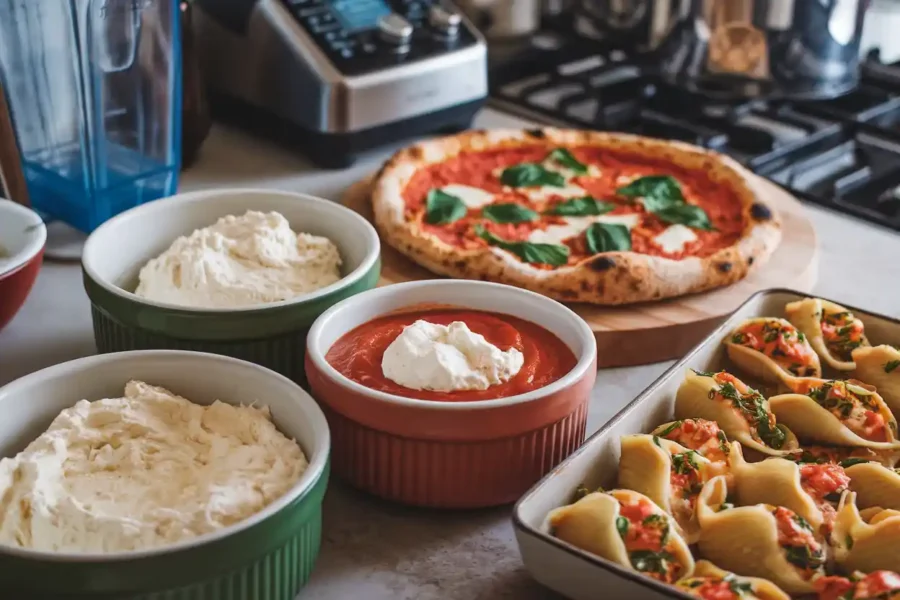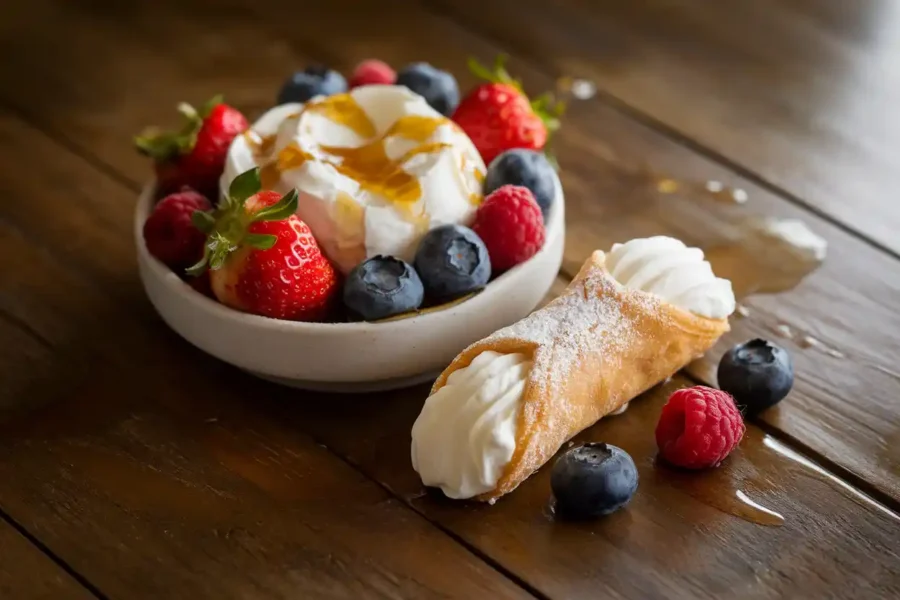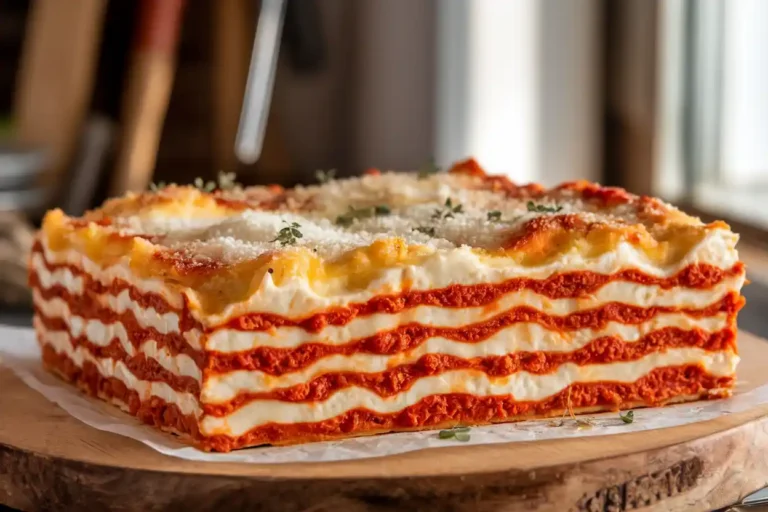Ricotta cheese is a beloved staple in kitchens worldwide. Its creamy texture and mild, slightly sweet flavor make it a favorite for pasta, pizza, and desserts. But have you ever wondered, is ricotta a good melting cheese? Unlike mozzarella or cheddar, ricotta behaves a little differently under heat. In this article, we’ll dive deep into the science behind ricotta, explore its culinary uses, and reveal whether it can truly melt or just blend into your favorite dishes.
Table of Contents
Introduction to Ricotta and Melting Cheeses
What is Ricotta Cheese?
Ricotta is a soft, creamy cheese traditionally made from the whey leftover during the production of other cheeses like mozzarella. Its name comes from the Italian word ricotta, meaning “re-cooked,” which refers to the reheating of whey during the cheese-making process. The result? A rich, slightly grainy cheese with a light, fluffy texture.
Unlike firmer cheeses like cheddar or Gouda, ricotta has a higher moisture content and lower fat percentage, making it perfect for spreading or dolloping rather than slicing. This unique structure influences how it reacts to heat, which we’ll explore in detail later.
Characteristics of Melting Cheeses
What makes a cheese melt beautifully? It all comes down to its composition. Cheeses that melt well, like mozzarella, have a balanced combination of fat, moisture, and protein. When heated, these elements break down, allowing the cheese to become gooey and stretchy. Firmer cheeses with lower moisture content, like Parmesan, tend to crisp rather than melt.
Ricotta, with its high moisture content, doesn’t behave like traditional melting cheeses. Instead of becoming stretchy or gooey, it softens and blends, creating a creamy texture that’s ideal for certain dishes.
Why the Question About Ricotta?
The question, is ricotta a good melting cheese, often arises when people try to use it as a substitute for mozzarella or other melting cheeses. While ricotta may not stretch like mozzarella, its ability to blend into sauces and baked dishes makes it a versatile ingredient. Understanding how ricotta works under heat can help you make the most of this creamy cheese in your cooking.
With this foundation, we’ll next dive into the science behind ricotta and what makes it unique in the world of cheese. Ready to uncover its secrets? Let’s continue!
The Science of Ricotta Cheese
Understanding Ricotta’s Texture and Composition
Ricotta is not your average cheese it stands out because of its unique texture and composition. Made from whey, ricotta is soft, creamy, and packed with moisture. Its delicate grainy structure comes from the coagulation of proteins during its production process. Unlike melting cheeses such as mozzarella or Gruyère, ricotta lacks the elasticity needed for gooey, stretchy results when heated.
The high moisture content in ricotta also prevents it from melting fully. Instead of breaking down into a liquid form under heat, it softens and blends with other ingredients, creating a creamy consistency. This characteristic makes it perfect for blending into pasta sauces or as a filling for lasagna.
The Role of Moisture and Fat in Melting
To understand why ricotta behaves differently under heat, it’s essential to look at the balance of moisture, fat, and protein. Cheeses with higher fat content and lower moisture like cheddar tend to melt beautifully. Ricotta, with its high water content, evaporates moisture during cooking instead of breaking down into a molten state. As a result, you’ll notice it remains slightly firm, offering a delightful texture when baked or added to warm dishes.
How Ricotta Compares to Classic Melting Cheeses
When asked, is ricotta a good melting cheese, the answer lies in comparison. Unlike cheeses like mozzarella, which becomes stringy when heated, ricotta maintains its shape while softening. This makes it ideal for recipes that require creaminess without the stringiness of traditional melting cheeses. It works best in dishes like stuffed shells, baked ziti, and desserts where its creamy texture enhances the dish.
Does Ricotta Cheese Melt?
What Happens to Ricotta Under Heat?
When heated, ricotta doesn’t melt in the traditional sense. Instead, it undergoes a transformation where its water content evaporates, and its proteins and fats soften. This reaction creates a creamy consistency rather than a runny texture. If you’ve ever baked ricotta in a lasagna, you’ve likely noticed that it retains its structure while blending seamlessly with other ingredients.
Baking with Ricotta: Oven Effects
In the oven, ricotta shines as a versatile topping or filling. When dolloped onto pizzas or spread over flatbreads, it softens and develops a light golden hue, adding a rich, creamy element to the dish. Ricotta doesn’t flow like traditional melting cheeses, but it holds its place, offering a texture contrast that’s both visually appealing and delicious.
Ricotta in Sauces: Does It Blend or Melt?
In sauces, ricotta blends rather than melts. It creates a velvety, smooth texture when whisked into warm liquids like tomato or cream sauces. This characteristic makes it an excellent choice for dishes like creamy ricotta pasta or baked casseroles. However, overheating can cause ricotta to curdle, so it’s best to add it at the end of cooking for a flawless, creamy result.
Ricotta might not behave like traditional melting cheeses, but its unique properties make it a star ingredient in various recipes. Next, we’ll explore how to maximize ricotta’s potential with specific cooking techniques. Let’s move forward!
Cooking Techniques for Ricotta Cheese
Tips for Using Ricotta as a Topping or Filling
When used as a topping or filling, ricotta excels in adding creaminess to dishes. On pizzas or flatbreads, dolloping ricotta instead of spreading it ensures it retains its texture and doesn’t dry out during baking. For filled pasta like ravioli or stuffed shells, mixing ricotta with herbs, garlic, or even Parmesan enhances its flavor and makes the filling irresistibly creamy.
To achieve the best results, always drain ricotta before use to remove excess moisture. This simple step prevents sogginess in your dishes and helps maintain the cheese’s desired consistency. Additionally, ricotta pairs well with a sprinkle of olive oil or a drizzle of honey, depending on whether you’re aiming for savory or sweet flavors.
When and How to Combine Ricotta with Other Cheeses
Combining ricotta with other cheeses, like mozzarella or Parmesan, creates a well-rounded flavor profile. For example, layering ricotta with mozzarella in lasagna balances the creaminess of ricotta with mozzarella’s melting properties. Parmesan, on the other hand, adds a nutty, savory kick that complements ricotta’s mild flavor.
Ricotta also works wonderfully in recipes that require contrast. Adding crumbles of feta or blue cheese to ricotta-based dishes can introduce tangy or sharp flavors, creating depth and complexity.
Dishes That Showcase Ricotta Without Melting
While ricotta doesn’t melt in the traditional sense, its creamy texture shines in dishes like baked ziti, stuffed peppers, and even cheesecakes. In these recipes, ricotta acts as a binder or a layer of creaminess, blending beautifully with other ingredients without losing its distinct texture.

Ricotta’s Nutritional Value and Versatility
The Health Benefits of Ricotta Cheese
Ricotta isn’t just creamy and delicious it’s also packed with nutrients. High in protein and calcium, ricotta is an excellent choice for adding nutritional value to your meals. Whether you’re using it in savory dishes or sweet desserts, it provides a healthy boost without the heaviness of some other cheeses. Its relatively low fat content compared to traditional melting cheeses like cheddar or mozzarella makes it a lighter option.
For those wondering, is ricotta a good melting cheese and how it fits into a healthy diet, the answer lies in balance. Its ability to maintain its texture without becoming greasy during cooking means you can use it to create flavorful, satisfying meals without adding unnecessary calories.
Creative Uses for Ricotta Beyond Melting
Ricotta’s versatility doesn’t stop at pasta or pizza. Its creamy consistency makes it an ideal ingredient for soups, dips, and even smoothies. Stir it into tomato soup for a velvety texture, or blend it with herbs and spices for a protein-packed dip. On the sweeter side, ricotta shines in cheesecakes, pancakes, and parfaits, pairing beautifully with fruits and honey.
If you’re experimenting with ricotta for the first time, don’t be afraid to get creative. Its mild flavor works well in both traditional and unconventional recipes, making it a valuable addition to any kitchen.
Debunking Myths About Ricotta Cheese
Addressing Misconceptions About Ricotta
One common misconception about ricotta is that it’s supposed to melt like mozzarella. While some cooks may find this surprising, the truth is that ricotta’s unique properties are what make it so special. Asking, is ricotta a good melting cheese?, misses the point of its culinary role. Ricotta isn’t meant to melt; it’s meant to enhance.
Another myth is that ricotta is only for Italian dishes. While it’s true that ricotta features prominently in recipes like lasagna and cannoli, its versatility extends far beyond Italian cuisine. From French soufflés to Middle Eastern dips, ricotta is a global ingredient.
Embracing Ricotta for What It Is
Instead of seeing ricotta’s non-melting nature as a limitation, think of it as an opportunity. Its ability to blend and complement other ingredients makes it a star in countless recipes. When used correctly, ricotta can transform an ordinary dish into something extraordinary.

FAQs About Ricotta and Cheese in Cooking
Is Ricotta Good on Pizza?
Yes, ricotta is an excellent addition to pizza! Its creamy, mild flavor pairs wonderfully with a range of toppings like spinach, roasted tomatoes, or spicy sausage. Instead of melting and spreading across the crust, ricotta softens into rich, velvety dollops, adding a luxurious texture to every slice.
What Cheese Works Best on Pizza?
Mozzarella is the go-to for its stretch and gooey texture, but ricotta holds its own in specific styles of pizza. For a gourmet touch, blend ricotta with mozzarella or Parmesan. Combining these cheeses creates a multi-dimensional flavor profile that caters to different preferences.
Can Ricotta Replace Traditional Melting Cheeses?
While it can’t replicate the stretchiness of mozzarella or cheddar, ricotta’s creaminess makes it a valuable substitute in many recipes. Use it in dishes that prioritize texture and richness, such as baked pasta or casseroles, where its unique properties shine.
What Are the Best Uses for Ricotta Cheese?
Ricotta’s versatility makes it a staple in both savory and sweet recipes. From filling cannoli and layering lasagna to topping pancakes or mixing into creamy dips, ricotta adapts to a variety of cuisines and dishes.
Conclusion: Ricotta’s Role in the Kitchen
Why Ricotta Stands Out Despite Its Non-Melting Nature
Is ricotta a good melting cheese? Technically, no it doesn’t melt in the same way as mozzarella or Gruyère. But that’s not a drawback; it’s what makes ricotta special. Its ability to stay creamy and maintain its structure under heat sets it apart from traditional melting cheeses. Whether it’s baked into lasagna or dolloped on pizza, ricotta adds a luxurious texture and rich flavor that enhances the overall dish.
Ricotta’s high moisture content and mild taste make it versatile for various culinary applications. From savory casseroles to sweet desserts, this cheese adapts effortlessly, offering a creamy consistency without becoming runny. Its uniqueness lies in its ability to blend, bind, or act as a topping while retaining its identity.
Encouraging Experimentation with Ricotta
Ricotta isn’t just for classic recipes it’s an invitation to get creative in the kitchen. Experimenting with ricotta can lead to delightful discoveries, like mixing it into savory dips or using it as a base for creamy pasta sauces. For a twist, try incorporating ricotta into breakfast dishes like pancakes or pairing it with fresh fruits and honey for a light dessert.
The key to mastering ricotta in your cooking is understanding its properties. While it may not melt traditionally, its versatility and flavor ensure it remains a favorite for chefs and home cooks alike. Let ricotta inspire your next culinary adventure!
Call to Action
Try Ricotta in Your Recipes Today!
If you’re wondering, is ricotta a good melting cheese?, this article has shown that while it may not melt traditionally, its creamy texture and unique qualities make it indispensable in countless dishes. Whether you’re crafting a baked ziti, topping a pizza, or exploring a new dessert, ricotta offers endless possibilities.

